9858 AN UNUSUAL REGENCY GILTWOOD SIDE TABLE IN THE MANNER OF MOREL AND HUGHES English. Early Nineteenth Century.. Measurements: Height: 37 3/8 (95cm) Width: 57″ (145cm) Depth 25 1/2″ (65cm)

Research
Of original giltwood with original red painted decoration. The original rectangular Egyptian granite top above a frieze with continuous raised trellis pattern interrupted at each corner by a rectangular block set with a stylized gilt composition leonine mask. The reeded legs each headed by bulbous stylized acanthus leaf clusters and turned waisted collars. The legs united by a red painted plateau with raised carved pea-molded edge. The whole raised on foliate stiff leaf carved feet issuing from a gadrooned bowl. Possibly once originally fitted with further shelf. The painted plateau has been restored to reinstate a narrow section to the rear. The constructional backrail has had a small section removed by a former owner.
Provenance:
Private Collection, London.
The present side table is an extremely fine example of the sophistication achieved in the design of English furniture in the early years of the nineteenth century. The classical detailing shapes the character of the table and demonstrates the influence of the archaeological revival on the form and decorative vocabulary employed in English furniture design at this date, particularly the acanthine leaf clusters, lion masks and lozenge pattern on the frieze.
A closely related table, but lacking the frieze section, was sold in the collection of Saul Steinberg Sotheby’s New York May 2000, Lot 149 (figure 1). Both are equipped with an unusual red painted lower shelf, probably to display and ancient object, and it is possible that the present piece was originally fitter with a further shelf, like the Steinberg example.
Nicholas Morel and Robert Hughes began their partnership in 1805, establishing a workshop on 13 Great Marlborough Street, London. The pair were highly skilled and successful cabinetmakers, who worked for the Prince of Wales’s, providing furnishings for Windsor Castle, Carlton House and the hunting box at The Grange, Hampshire. Other important patrons included the Duke of Northumberland, 4th Marquess of Bath and the Earl of Mansfield.
The granito Egiziano top is notable and its existence on the table as specimen stone from the ancient world indicates a scholarly allusion to the base. Mined exclusively in the Aswan and Shellal districts of the Nile Valley in Egypt, the stone, of a rich red ground flowered profusely with black and reddish white, is very rare, according to Faustino Corsi’s Delle pietre antiche (Rome, 1845).1
Footnotes:
Corsi, F. (1845), Delle pietre antiche : trattato di Faustino Corsi. (Edizione terza : con notabile aggiunta al terzo libro in cui sono indicate e discritte tutte le colonne ed alcuni masse di pietre antiche ragguardevoli per grandezza o per rarità esistenti in Roma.). Tip. di G. Puccinelli, Roma. 210-213.
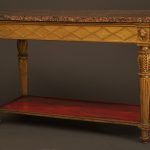
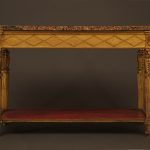
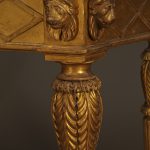
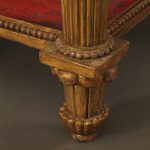
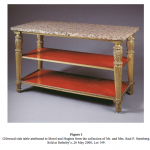
Comments are closed.